Know your birds
As steep penalties apply if a protected species is shot, it pays to know your birds. The species legal in each state vary so it is important to check with the appropriate authorities before assuming anything. The following information should help get you started in correctly identifying your game birds.
Note: This is not a comprehensive guide to Australian waterfowl. For more detailed information, contact your state/territory wildlife authority.
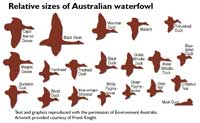 Waterfowl guide
Waterfowl guide
Most waterfowl likely to be encountered while hunting in Australia are included in this general guide. However, some of them are not legal game birds and are protected by law. Remember that the regulations governing hunting vary from state to state so you should know the laws of the state or territory in which you are hunting and ensure that you take only those ducks that are legal game.
There are also many species of waterbirds, such as coots, swamphens, grebes and cormorants, not included in these pages that you are likely to encounter. These birds are not legal game and are usually protected by law.
The game status of birds may change yearly in each state/territory according to climatic conditions. Be sure to contact your wildlife authority before you hunt or take a waterfowl identification test.
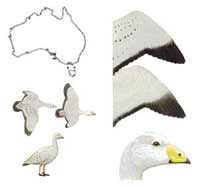 Cape Barren Goose
Cape Barren Goose
Fully protected in all states and territories and must not be shot.
In flight, the cape barren goose is a large, grey goose, uniform in color except for a black tail and black wing tips. The legs are large and pink and the feet are black. The species has a prominent greenish-yellow cere (fleshy covering around the nostrils).
The male and female have a similar appearance.
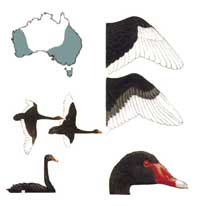 Black Sawn
Black Sawn
Fully protected in all states and territories and must not be shot.
In flight, a large black swan with a very long slender neck with white flight feathers in wings. The flight is slow with slow wing beats.
Male and female have a similar appearance; juveniles are grey-brown with black tips to the outer white flight feathers, and cygnets are light grey, downy with grey-black bill and feet.
This species should never be confused with Australian game waterfowl and must not be shot.
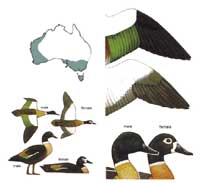 Mountain duck
Mountain duck
Legal game in Victoria, Tasmania and South Australia.
The mountain duck is the largest Australian duck. Its dark body contrasts with brilliant white wing patches.
In flight, the mountain duck has large, prominent white wing patches on the shoulders of the wing, a dark body, white underwings, chestnut-colored breast and a white neck ring.
On the water or land, it looks like a large duck with a dark head, white neck ring, and yellow-brown or chestnut-colored breast.
The female and young birds have a white ring around the eye and a white face patch.
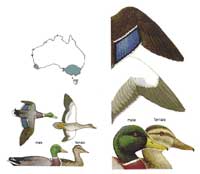 Mallard
Mallard
An introduced species and is not protected anywhere in Australia.
In flight, the male has dark foreparts and undertail, a white breast and white underwings. The female has white underwings and a paler belly than the black duck. Both sexes have two white bars on the upper wing.
On the water, the mallard is a medium-sized duck. The male has a greyish body, dark head, neck and chest, while the female has a much less distinct face stripe than the black duck. Both sexes have a whitish tail.
In non-breeding (eclipse) plumage, the male is similar to the female but has a dull-green bill and may have traces of green on the head and chestnut on the breast.
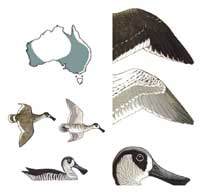 Pink-eared duck
Pink-eared duck
Legal game in Victoria, South Australia and the Northern Territory.
In flight, the head is held high with the heavy bill angled downward. The species has a light underbody, white trailing edges on upper-wing and tail and a white crescent on the rump. The wings are rounded.
On the water, it appears as a small, light-colored duck floating high with zebra stripes on the body, a large bill and distinctive forehead.
The male and female have a similar appearance.
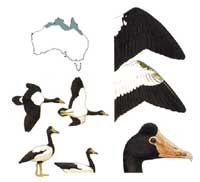 Magpie geese
Magpie geese
Legal game in Northern Territory.
In flight, the magpie goose is a large black and white goose with mainly black upper parts and contrasting white underparts. The wings are rounded with a slow flapping beat.
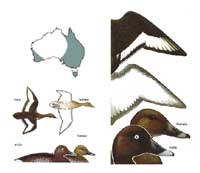 Hardhead
Hardhead
Legal game in Victoria, South Australia, Queensland and the Northern Territory.
A medium-sized, dark-brown bird with white feathers under the tail. The male has a white eye.
In flight, the hardhead has a large white band across the belly, the underwing is translucent white and the upper wing has a white strip on the trailing edge. The hardhead is very swift in flight with rapid, short wing beats. The wings are narrow and pointed and set well back on the body.
On the water, the hardhead is a dark colored duck, floating very low and sometimes the white undertail is visible.
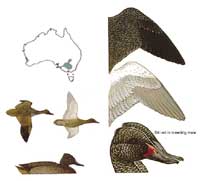 Freckled duck
Freckled duck
Fully protected in all states and territories and must not be shot.
The freckled duck is grey-brown in color and covered with fine white freckles. It is a uniformly colored bird with little contrast and shows no wing pattern. It has a small tuft of feathers on the head and the bill has a curved, scooped appearance. The male’s bill turns bright red at the base during the breeding season.
In flight, the freckled duck is an all dark bird, paler on the belly and underwing, with a large head and fairly short, thick neck carried slightly depressed, which gives a hunched appearance. Freckled duck generally fly low and circle around and around wetlands before leaving. They often mix with other species.
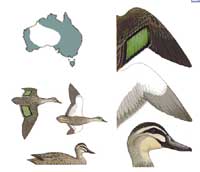 Black duck
Black duck
Legal game in Victoria, South Australia, Tasmania, Queensland and the Northern Territory.
The black duck is a dark-brown bird with a pale face and throat. It has a distinctive black eye-stripe that stretches from the top of the bill through the eye. The male and female have a similar appearance.
In flight, the black duck is a dark bird with swift wing beats and a slender neck. The upper wing has no white but does have a green glossy color patch on it. The underwing is white.
On the water, the black duck is a medium-sized duck with a slender head and neck that is carried erect.
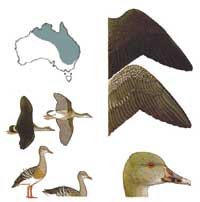 Grass whistle duck
Grass whistle duck
Legal game in Queenslandand the Northern Territory.In flight, the grass whistle duck adopts a distinctive posture, with a depressed neck, trailing legs, light belly and a less obvious white rump than the water-whistle duck. It has short, rounded wings with slow wing beats.
On the water or on land, the grass whistle duck is a medium-sized duck with a pale body and long, buff plumes on the flank. It has a distinctive erect posture.
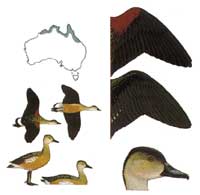 Water whistling duck (Wandering Whistling
Duck)
Water whistling duck (Wandering Whistling
Duck)
Legal game in Queensland and the Northern Territory.
The male and female have a similar appearance. The species occurs in dense flocks, whether on land, water or in flight.
In flight, the water-whistle duck adopts a distinctive posture, with a depressed neck and trailing legs, a dark belly, chestnut shoulders and a white rump. It has short rounded wings with a slow wing beat.
On the water or on the land, the water-whistle duck is a medium-sized duck with a dark body and short, white plumes on flank.
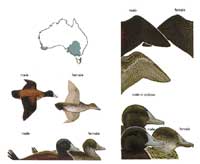 Blue-billed duck
Blue-billed duck
Fully protected in all statesand territories and must not be shot.
In flight, the blue-billed duck patters along the surface before take-off, where it adopts a tail-heavy posture with very rapid wing beats and flies low to the water’s surface. In flight, the species appears as a dark bird with no color patches or contrasting plumage. There is no pattern on the wing. The blue-billed duck is seldom observed to fly.
On the water, the blue-billed duck swims swiftly and dives repeatedly. It appears as a small, dark duck floating very low with a heavy head, compact body and, occasionally, the stiff, erect tail is visible. The male has a brilliant blue-colored bill during the breeding season (generally September to November).
The male is in the non-breeding (eclipse) plumage for most of the winter.
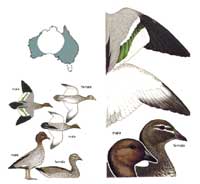 Wood duck (Maned Duck)
Wood duck (Maned Duck)
Legal game in Victoria, South Australia, Queensland and the Northern Territory.
The wood duck is a medium-sized goose-like duck with long legs, extended neck, short head and is related to the pygmy-geese of tropical Australia.
In flight, the wood duck has slow wing beats, large white patches on the rear of the upper wing near the body and a white triangle on the upper wing near the body. The male has a black undertail and belly, while the female has a white belly and eye stripes.
On the water or on land, the wood duck is a medium-sized, light-colored duck with a dark head, a characteristic high-tailed posture on water and erect posture on land.
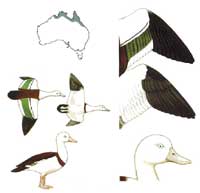 Burdekin duck
Burdekin duck
Fully protected in all states and territories and must not be shot.
In flight, the burdekin duck has prominent white shoulder patches and an all white head, neck and belly and bases of wings. It has a dark neck ring, wing tips and tail.
On the water or on land, the burdekin duck is a medium-sized duck with a white head, neck and belly and a dark back.
